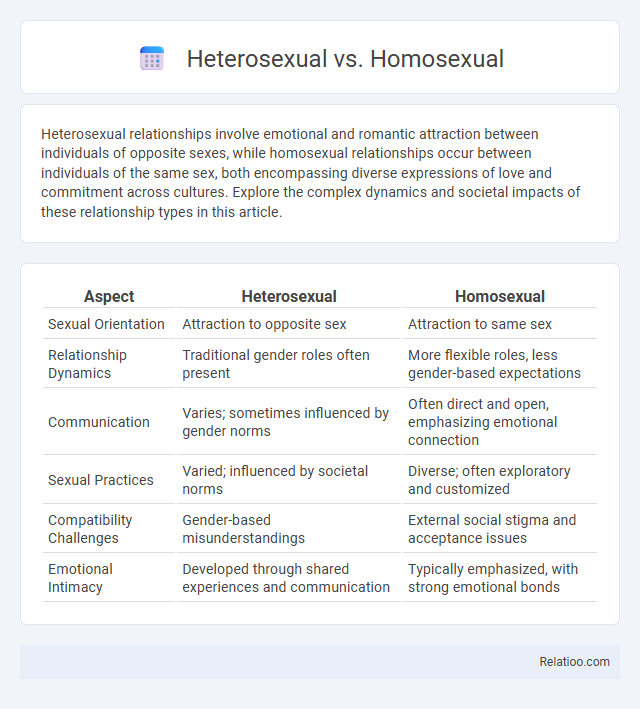Heterosexual relationships involve emotional and romantic attraction between individuals of opposite sexes, while homosexual relationships occur between individuals of the same sex, both encompassing diverse expressions of love and commitment across cultures. Explore the complex dynamics and societal impacts of these relationship types in this article.
Table of Comparison
| Aspect | Heterosexual | Homosexual |
|---|---|---|
| Sexual Orientation | Attraction to opposite sex | Attraction to same sex |
| Relationship Dynamics | Traditional gender roles often present | More flexible roles, less gender-based expectations |
| Communication | Varies; sometimes influenced by gender norms | Often direct and open, emphasizing emotional connection |
| Sexual Practices | Varied; influenced by societal norms | Diverse; often exploratory and customized |
| Compatibility Challenges | Gender-based misunderstandings | External social stigma and acceptance issues |
| Emotional Intimacy | Developed through shared experiences and communication | Typically emphasized, with strong emotional bonds |
Defining Heterosexuality and Homosexuality
Heterosexuality is defined as a sexual orientation characterized by emotional, romantic, or sexual attraction between individuals of opposite sexes or genders. Homosexuality refers to a sexual orientation where individuals experience attraction toward others of the same sex or gender. Both heterosexuality and homosexuality are fundamental components of the broader spectrum of human sexual orientation, encompassing diverse patterns of attraction and identity.
Historical Perspectives on Sexual Orientation
Historical perspectives on sexual orientation reveal diverse cultural interpretations of heterosexuality and homosexuality across ancient civilizations and modern societies. Early societies often recognized multiple forms of sexual expression, with some cultures celebrating same-sex relationships, while others enforced strict heterosexual norms rooted in procreation. Contemporary understanding frames sexual orientation as a complex, innate aspect of identity, challenging earlier moralistic and pathological views.
Biological Factors Influencing Sexual Orientation
Biological factors influencing sexual orientation include genetic, hormonal, and neurological components that contribute to the development of heterosexual and homosexual preferences. Studies on twin genetics reveal a higher concordance rate for sexual orientation among identical twins compared to fraternal twins, indicating a hereditary element. Prenatal hormone exposure, particularly variations in androgens, also plays a crucial role by affecting brain structures associated with sexual preference, supporting the complexity of sexual orientation beyond simple categorization.
Social and Cultural Attitudes
Social and cultural attitudes toward heterosexuality and homosexuality vary significantly across regions, with heterosexuality often viewed as the default sexual orientation in many societies. Homosexuality faces varying degrees of acceptance, ranging from legal recognition and social inclusion in progressive cultures to stigmatization and discrimination in conservative environments. Sexual orientation, encompassing both heterosexual and homosexual identities, continues to influence social norms, policies, and cultural narratives worldwide, reflecting ongoing shifts in human rights and equality discourses.
Legal Rights and Protections
Legal rights and protections for heterosexual, homosexual, and other sexual orientations vary significantly across jurisdictions, impacting your ability to marry, adopt, or access healthcare equally. Anti-discrimination laws in many countries safeguard employment, housing, and public services for all sexual orientations, though enforcement and scope differ widely. Understanding these legal frameworks ensures you are aware of your rights and protections related to sexual orientation in your area.
Myths and Misconceptions
Myths and misconceptions often distort understanding of heterosexuality, homosexuality, and broader sexual orientation, falsely labeling them as choices or phases rather than innate aspects of identity. Scientific research confirms that sexual orientation is a complex interplay of genetic, hormonal, and environmental factors, not influenced by personal decisions or upbringing. Your awareness can challenge stereotypes by recognizing that all orientations deserve equal respect and validation based on authentic human experience.
Mental Health and Well-being
Mental health challenges often vary across different sexual orientations, with LGBTQ+ individuals, including both homosexual and bisexual people, experiencing higher rates of anxiety, depression, and stress due to societal stigma and discrimination compared to heterosexuals. Access to supportive environments and affirming mental health services significantly improves well-being for individuals regardless of their sexual orientation. Understanding how your sexual orientation intersects with mental health is essential for fostering resilience and seeking appropriate care.
Representation in Media and Literature
Representation of heterosexual, homosexual, and broader sexual orientations in media and literature has evolved significantly, reflecting diverse experiences and challenging traditional norms. Your exposure to varied sexual orientations in narratives promotes inclusivity, reduces stigma, and fosters understanding across communities. Accurate and multidimensional portrayals influence societal attitudes, making media and literature powerful tools for visibility and acceptance.
Challenges and Discrimination
Heterosexual individuals often face fewer societal challenges compared to those identifying as homosexual, who encounter discrimination stemming from prejudice and misunderstanding in various sectors including employment, healthcare, and social settings. Sexual orientation diversity frequently results in systemic barriers such as legal inequalities and social stigma, directly impacting mental health and access to resources for LGBTQ+ communities. Understanding your sexual orientation should come with support and equal rights to combat discrimination and promote inclusion across all areas of life.
Promoting Acceptance and Inclusivity
Promoting acceptance and inclusivity requires recognizing that heterosexual, homosexual, and other sexual orientations are all natural variations of human diversity. Inclusive policies and education that highlight respect for all orientations foster safer, more supportive environments in schools, workplaces, and communities. Emphasizing empathy and understanding helps dismantle stigma and discrimination, advancing equal rights and social harmony.

Infographic: Heterosexual vs Homosexual
 relatioo.com
relatioo.com